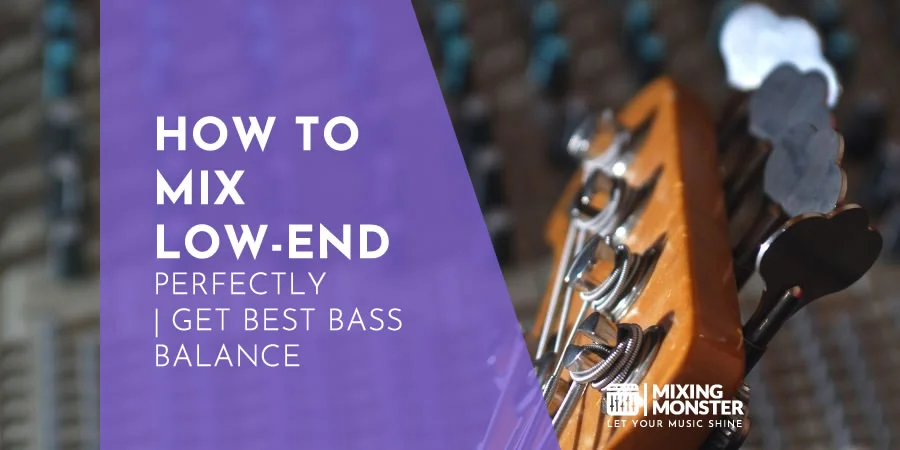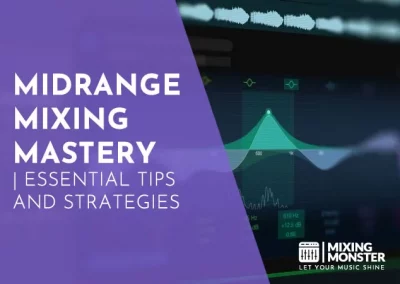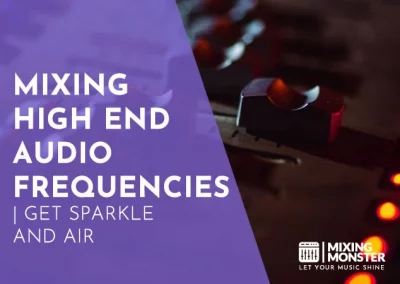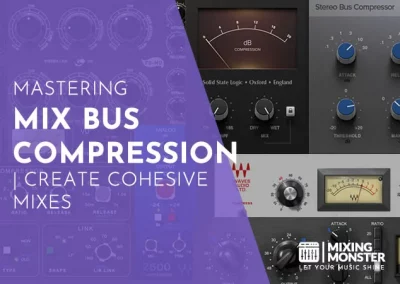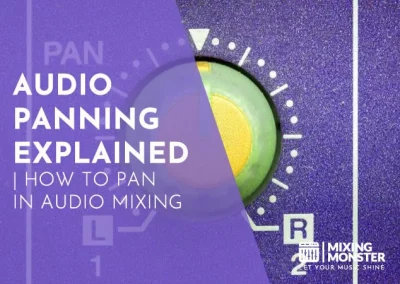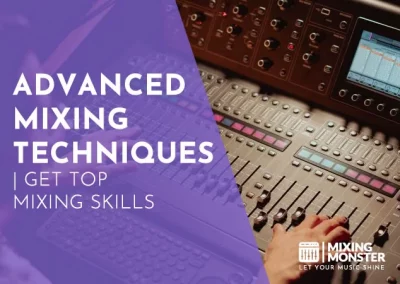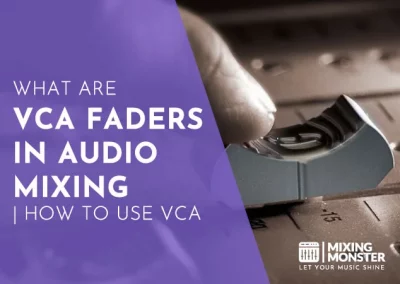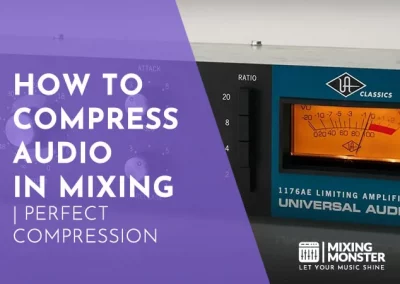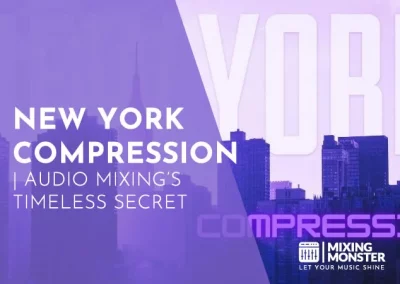Home > Blog > Mixing > Mixing Techniques
Disclosure: Some of the links below are affiliate links, meaning that at no additional cost to you, we will receive a commission if you click through and make a purchase. Read our full affiliate disclosure here.
Achieving the perfect mix in music production crucially depends on controlling the low end. “How to mix low end” is a fundamental skill that can make or break your track, ensuring that your basses and kick drums punch through the mix without overpowering other elements.
The low end of the frequency spectrum, typically ranging from 20 Hz to 250 Hz, is essential for providing a solid foundation in any mix. In this frequency range, listeners feel the music’s weight and power. Mixing the low end involves carefully balancing these frequencies to avoid muddiness, ensure clarity, and implement techniques to help the bass sit well with the kick drum and other lower-frequency instruments.
In this article, you will uncover the basics and more advanced techniques that address common low-end mixing challenges. From genre-specific considerations to sophisticated processing methods, you’ll learn how to enhance the foundation of your tracks for a powerful, professional sound. Whether fine-tuning the kick-bass relationship or ensuring your low end translates well across various listening environments, the following insights will arm you with the tools to elevate your audio mixing skills.
KEY TAKEAWAYS:
- Controlling low frequencies is critical for a clean mix.
- A balanced low end underpins the entire mix’s energy.
- Learning advanced techniques can tackle common mixing challenges.
Table Of Contents
1. Defining Low-End In Audio Mixing
2. The Role Of Low-End In Audio Mixing
3. Common Problems With Low-End Frequency Content
4. Balancing Kick Drum And Bass
5. How To Perfectly Balance Low End In A Mix
6. Processing Bass In A Mix
7. Parallel Processing Techniques For Bass
8. Genre Considerations For Bass Mixing
9. Advanced Low-End Mixing Techniques
10. Get The Best Bass Balance
11. FAQ

1. Defining Low End In Audio Mixing
When discussing audio mixing, the low end refers to the frequency range encompassing the sound spectrum’s deepest, most vibrationally rich parts. These foundational elements provide the weight and power to a track.
Explanation Of Frequency Range In Mixing
The low-end consists of bass frequencies ranging from about 20 Hz to 250 Hz. This spectrum is critical because it gives music a sense of depth and fullness. Within this range, you’ll encounter different classifications of low frequencies:
- Sub Bass:
Ranging from approximately 20 Hz to 60 Hz, these are frequencies often felt more than heard and provide the rumble in a mix. - Bass:
Spanning from 60 Hz to 250 Hz, this range is where the fundamental notes of the bass instruments are most prominent.
Monitoring and mixing these carefully is essential, as low frequencies are non-directional and can quickly muddy a mix if not appropriately managed.
Characteristics Of Low End Sounds In A Mix
Low-end sounds in a mix have specific properties that distinguish them from higher-frequency content:
- Physical Impact:
These frequencies can physically impact the listener, often experienced as a thump or vibration. - Fullness:
Properly managed low-end frequencies add fullness and warmth to your mix, creating a more immersive listening experience.
Handling low-end is a balancing act; it requires a subtle touch to ensure clarity while maintaining the desired power and weight in your track.
2. The Role Of Low End In Audio Mixing
The low-end frequencies in audio mixing lay the groundwork for rhythm and evoke emotion, while technical considerations between mono and stereo tracks can significantly influence the final mix.
Establishing Rhythm And Groove
Your mix’s groove hinges on the kick drum and bass relationship, forming a tight, rhythmic foundation. 808s, characterized by their deep and extended bass response, are critical in genres like hip-hop and electronic music for forging this fundamental beat. A well-mixed low-end anchors the rhythm section, giving the listener a sense of palpable movement and energy.
Low End And Emotional Impact
The bass frequencies carry a substantial amount of the music’s emotional weight. A robust low-end can instill a sense of power or unease, while a softer bass can soothe or create a sense of anticipation. When mixing, focusing on the interplay between the low-end elements can help express the track’s intended emotion more effectively.
Low End: Mono Vs. Stereo Considerations
Maintaining low-end elements like the bass and kick in mono ensures a strong, centered foundation in your mix, with a consistent and powerful impact across all playback systems. A narrow stereo image for these elements reduces phase issues. It provides a dependable anchor while experimenting with stereo, which can sometimes lead to a more spacious mix but requires careful attention to maintain clarity and impact.
3. Common Problems With Low End Frequency Content
In the realm of audio mixing, the low-end holds fundamental importance but is prone to issues that can compromise the quality of a track. Your awareness and ability to mitigate these common problems can greatly enhance the clarity and impact of the bass frequencies.
Bass Muddiness And Lack Of Clarity
Bass muddiness occurs when the low-end sounds are indistinct and lack definition. This often stems from excess frequency overlap between instruments that operate within the same frequency range. To combat this, apply targeted equalization (EQ) to ensure each instrument occupies its space. For instance, if your kick and bass guitar are clashing, you might use a high-pass filter on the bass guitar to allow the kick to punch through.
Low End Phase Issues And Overlapping Frequencies
Phase issues can wreak havoc on low frequencies, causing specific notes to disappear or be inconsistently reproduced by your speakers. This often occurs due to overlapping frequencies and can be especially problematic when multiple tracks contain similar frequency content. Utilize phase alignment tools and ensure the phase relationship between low-end elements like the kick drum and bass.
Bass Room Acoustics And Monitoring Challenges
Your room acoustics can misrepresent low-end frequencies, misleading your mixing decisions. Inadequate acoustic treatment may result in standing waves and bass build-up at certain spots in the room. Employ bass traps and other treatment solutions to minimize these issues.
Additionally, ensuring that your monitoring system is accurate and well-positioned in the room is critical for trustworthy low-end reproduction. Remember that room size and shape influence how sound waves travel and are perceived, so adjusting the placement of your monitors could help reduce acoustic anomalies.
4. Balancing Kick Drum And Bass
Achieving the right balance between your kick drum and bass is essential for a clear and powerful mix. Mastering their relationship and how they occupy the sonic space will ensure your low-end packs the intended punch without muddiness.
Understanding The Relationship Between Kick And Bass
The kick drum and bass are the foundation of rhythm and energy in many musical genres. They should work together harmoniously, with the kick providing the impact and the bass offering tonal substance. However, if not properly managed, this pairing can lead to conflicts within your mix, particularly in the low-frequency range.
To achieve a well-balanced low end, it is crucial to understand the frequency content in which each element resides and how they can complement each other.
Techniques For Achieving Bass Clarity And Punch
When your goal is to make both bass and kick discernible, you need to apply these main techniques:
- EQ (Equalization):
- Kick:
Apply a high-pass filter to eliminate unnecessary sub-bass frequencies that are not contributing to the punch. Emphasize the beater frequency content—around 2-4kHz—to enhance the kick’s attack. - Bass:
Carve out a small pocket in the bass’ equalization to give the kick’s fundamental frequency some breathing room. This can involve reducing specific bass frequencies that overshadow the kick. - Balancing Levels:
- Adjust the volume balance between the two to allow each to have its moment. This adjustment often requires iteration to find the ideal spots where both the kick and bass are pronounced.
Introduction To Bass Sidechaining Techniques
Sidechain compression is a dynamic mixing tool that allows you to automatically balance the levels of the kick and bass in real time. By sidechaining the bass to the kick:
- The bass is momentarily reduced in volume every time the kick hits, creating space for the kick to cut through with clarity.
- This ensures that each hit has maximum punch without the bass conflicting.
Here is a simplified step-by-step on how to set up basic sidechain compression:
- Insert a compressor on the bass track.
- Select the kick drum as the sidechain input source within the compressor.
- Adjust the threshold until you achieve the desired ducking effect every time the kick hits.
How To Balance Kick And Bass:
- Use EQ to carve space for each to exist without stepping on the other’s frequency range.
- Decide on the kick or bass to dominate specific parts of the track for a more dynamic mix.
- Implement sidechain compression to allow the kick to punch through the mix at the moment of impact.
By carefully blending these elements, you can reach a professional low end that adds depth and drive to your mixes without overpowering or becoming muddy.

5. How To Perfectly Balance Low End In A Mix
A professional sound must achieve a perfectly balanced low end in your mix. Your focus must be precise equalization, adept compression, and careful monitoring to ensure clarity and punch in your bass frequencies.
The Importance Of Monitoring And Room Treatment
An accurate listening environment is paramount when mixing low-end. Invest in high-quality studio monitors or headphones designed for a flat response and consider acoustic room treatment to achieve a clean mix. Absorption panels can help reduce unwanted reflections, and bass traps can minimize room modes, resulting in a more truthful sound and a balanced low-end response.
Bass EQ To Carve Out Space
Applying EQ on the bass to carve out space is crucial for clarity when mixing. Use a high-pass filter to remove unnecessary sub-frequencies from non-bass instruments, allowing your bass and kick to breathe. Apply precise cuts to remove any boomy or boxy tones, and consider a gentle boost around the fundamental frequency for definition. Remember, each instrument should sit well without masking the others.
Bass Compression Strategies For A Consistent Low-End
Compression maintains a consistent low end and prevents dynamics from overwhelming the mix. Set the threshold to capture the peaks and choose a ratio that evens the performance without squashing the life out of your bass. Fast attacks and releases can add punch; however, adjust them carefully to avoid losing the naturalness of the performance.
Low End Multiband Compression To Tame Jumpy Notes
Multiband compression allows you to target specific frequency ranges with compression, which is perfect for taming jumpy notes in the low end. This selective approach ensures that only the problematic frequencies are controlled while maintaining the overall energy. You can smooth out uneven bass response using a narrower bandwidth without affecting the rest of the mix.
6. Processing Bass In A Mix
Optimizing bass in your mix is essential for achieving a powerful and clean low end. Focused EQ, precise compression, and careful harmonic enhancement are crucial to bringing the best out of your bass tracks.
EQ Techniques For Bass Clarity And Presence
When adjusting EQ on bass, your main goal is to enhance clarity and presence without overwhelming the mix. Here are some targeted steps:
- Cut Unnecessary Lows:
Apply a high-pass filter to remove subsonic frequencies that might muddy the mix. - Find the Fundamental:
Boost the fundamental frequency slightly to reinforce the bass note. - Carve Out Space:
Create space for the bass by cutting competing frequencies on other instruments. - Add Presence:
Apply a slight boost around 700 Hz – 1 kHz to bring out the pluck or pick of the bass.
Compression Settings For Different Bass Dynamics
Compression is vital to maintaining consistent dynamics in your bass. Follow this guidance:
- Threshold:
Set your compression threshold to engage only when the bass hits the loudest points. - Ratio:
Use a moderate ratio (around 4:1) to maintain natural bass dynamics without over-compression. - Attack/Release:
A slower attack allows the initial transient to pass through, while a quicker release will maintain energy.
Harmonic Excitement For Bass Fullness
To enhance the fullness and warmth of your bass, consider these techniques:
- Apply a harmonic exciter or saturation to add rich overtones.
- Focus on lower midrange harmonics to increase warmth without creating mud.
- Balance the gain so that the added harmonics enhance rather than dominate the bass tone.
7. Parallel Processing Techniques For Bass
In this section, you’ll learn how to use parallel processing to elevate the bass in your mixes. These techniques can help you enhance the tone and add character without compromising the balance of your low end.
Understanding Parallel Processing
Parallel processing is a mixing technique where you blend an unprocessed signal with a processed one, retaining the original’s dynamics while adding the desired effect. When applied to bass, parallel processing lets you enhance dynamics and sustain, introduce additional harmonics, or fatten the sound without overwhelming the mix.
Applying Parallel Bass Compression For Enhanced Tone
To apply parallel compression:
- Duplicate your bass track.
- Apply heavy compression to the duplicate with a compressor to reduce its dynamic range.
- Blend it with the original track to taste.
This technique helps you maintain the natural sound of your bass while the compressed signal adds a consistent presence that cuts through the mix.
Using Parallel Bass Distortion For Grit And Character
For grit and character:
- Duplicate your bass track.
- Add distortion to the duplicate to generate harmonics and grit.
- EQ the distorted signal, if necessary, to fit the mix.
- Mix it with your clean bass track for added depth.
Distortion can give your bass line a more aggressive edge and help it stand out, particularly in heavier genres or where you want it to play a leading role. Use this parallel effect to infuse your bass with personality and a distinct sonic flavor.
8. Genre Considerations For Bass Mixing
In mixing low-end, your approach should vary significantly depending on the genre. The characteristics of bass in hip-hop differ vastly from those in rock or electronic music, influencing the techniques and tools you’ll employ.
Adapting Bass Mixing Techniques For Different Music Styles
The bass plays a foundational role across all genres, but how you mix the low end must align with the stylistic needs of the music. When tackling a synth bass prevalent in electronic music, you’ll often prioritize clear, punchy sounds that cut through dense arrangements.
EQ sweeps help eliminate unwanted frequencies, lending clarity to the mix. Conversely, rock music favors a live bass guitar’s natural warmth and dynamics, where a combination of EQ and gentle compression can retain the instrument’s character while ensuring it sits nicely in the mix.
Bass In Different Genres: Hip-Hop, Rock, And Electronic Music
In hip-hop, the bass not only provides a rhythmic foundation but often carries the melody as well. It’s critical to ensure the kick drum and bass elements are not conflicting—sidechain compression might be necessary to allow the kick to punch through.
Rock music requires careful attention to ensure the bass guitar meshes with the kick drum, often employing EQ to define their respective spaces.
For electronic music, you’ll likely use a synth bass that needs to be powerful yet not overwhelm the balance of synthetic textures. Automation might be a helpful tool to adjust the bass levels dynamically throughout the track.
By considering these genre-specific nuances in your music production, your bass mixing can enhance your tracks’ overall impact and coherence
9. Advanced Low End Mixing Techniques
While mixing low-end, your precision and technique can transform a good track into a professional-sounding masterpiece. Let’s explore some advanced methods that elevate your low-end mix.
Dynamic Bass EQ For Controlling The Low End
Dynamic EQ allows you to control and sculpt your bass frequencies without affecting the punch and dynamism of your mix. It’s handy for moments when the bass overpowers the track. Unlike static EQ, a dynamic EQ only affects the targeted frequencies when they exceed a certain threshold, ensuring a clean mix.
Bass Saturation For Warmth And Depth
Adding saturation to your bass can introduce harmonics and enhance the perceived loudness and warmth. It is crucial, as more saturation can muddy your low end. A slight touch of saturation brings out the character in your bass, especially in systems with less bass response.
Stereo Imaging And Low End Management
Managing the stereo imaging of the low end ensures clarity and prevents phase issues. Generally, keeping low-end elements like kick drums and bass lines centered and mono is advisable. This tightens the mix and guarantees a solid foundation across various playback systems.
|
Technique |
Role in Low-End Mixing |
|
Dynamic Bass EQ |
Targeted attenuation of problem frequencies |
|
Bass Saturation |
Enriches harmonics, adds warmth |
|
Stereo Imaging |
Avoids phase issues, and ensures mono compatibility for low-end |
Using tools like multiband compressors and high-pass filters strategically, you can maintain control over the low end, ensuring that it’s powerful without dominating the other elements of your mix.
10. Get The Best Bass Balance
Achieving the best bass balance in your mixes requires careful attention to the low-end frequencies, ensuring they blend seamlessly with the rest of your track. This balance is pivotal for the clarity and impact of your music.
Recap Of How To Mix Low End
Mixing the low end is essential for a powerful and clear sound in music production. Start with:
- Reference Tracks:
Utilize these to benchmark the bass in your mixes. - Listening Environment:
Make sure it’s acoustically treated to perceive bass frequencies accurately. - Experience:
Trust your ears and seek feedback to improve your skills.
Emphasize the attack of bass elements to maintain definition and punch. Use EQ thoughtfully to carve out space, avoiding clutter in the frequency spectrum.
Master Low End Mixing
When it comes to mastering low-end mixing, consider the following:
- Tips:
Research and apply professional insights—each nugget of wisdom can refine your technique. - Prevent Ear-Fatigue:
Don’t underestimate the importance of breaks to prevent ear fatigue. - Music Production:
Keep your software and tools up-to-date to leverage their full potential in crafting your sound. - Mixes:
Consistently check your mixes on various playback systems to ensure a balanced low-end across listening scenarios.
Careful frequency management and dynamic control (compression) are crucial. Consider sidechain techniques to create room for the kick, ensuring it cuts through the mix!
Happy bass mixing!
11. FAQ
1) What techniques can improve the low-end balance between bass and kick drums?
To maintain a clear balance between the bass and kick drums, pay close attention to their frequency ranges and use sidechain compression to allow the kick to cut through. Proper equalization, such as carving out frequencies from the bass where the kick needs to stand out, will promote harmony between the two. Learn more from iZotope’s tips for mixing low-end.
2) What are the best practices for applying compression to the low end?
When applying compression to low frequencies, it’s crucial to use a slower attack time to maintain the natural character of bass sounds and kicks. This enables the transients to pass through before compression, thus preserving their impact. Adjust the release settings to match the tempo of the music, ensuring a consistent groove. Consider the techniques outlined in the Pro Audio Files guide for further details.
3) Which methods are effective for enhancing the low end of headphones during mixing?
To enhance the low end on headphones, it’s important to use reference tracks to compare your mix against commercially successful tracks with a well-mixed low end. Additionally, consider mixing at lower volumes to reduce ear fatigue and ensure the accuracy of bass levels. Switching to headphones specialized for low-frequency reproduction can also offer a more accurate monitoring environment. Explore methods in this in-depth article on EQ and low-end.
4) How can one avoid having too much low-end in a mix?
Avoid an overpowering low end in your mix by using high-pass filters to remove unnecessary frequencies from non-bass instruments. Regularly check your mix in mono to detect and correct frequency masking. Additionally, use spectrum analyzers and take breaks during mixing to rest your ears.
5) What strategies can help increase the presence of low frequencies in a mix?
Increasing the presence of low frequencies can be achieved by subtle saturation to add harmonics, making the bass audible on smaller speakers. Layering bass tracks with different textures at compatible frequencies can enrich the low end.
6) How can you add depth to the low end of guitars in mixing?
To add depth to the low end of guitars, consider using equalization to gently boost the desirable low frequencies while being cautious not to muddy the mix. Multi-mic recording techniques can capture richer, low-end details of guitar tones that can enhance the depth of the mix.

